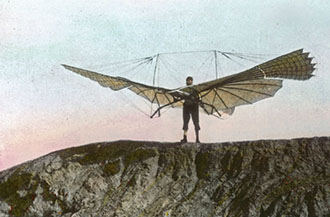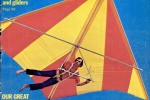Mission Soaring Center - 40 Years of Hang Gliding
Forty years! That covers the lion's share of the history of Hang gliding. And Mission Soaring LLC has been there.
Pat Denevan, owner and founder of MSC, had read about a bamboo and plastic do-it-yourself glider in Popular Mechanics like the rest of us.
Unlike the rest of us, he decided to actually build one. But an article in Joe Foust's "Low and Slow" newsletter convinced him that aluminum was the way to go. Armed with plans from Michael Markowskis' "The Hang Gliding Bible", he headed to Los Angeles, CA, for the 1972 Turkey Day Fly-in, with the ulterior motive of a stop at Washington Supply Hardware, a Mecca of aerospace surplus including aluminum tubing. The Fly-in didn't happen, but there was plenty of action to check out at an ocean front dune called Dockweiller Beach, in El Segundo, CA. And Washington Supply sold Pat the last useable lengths of tubing. No one knew much about alloys or temper back then. One piece he purchased had the flexibility of overcooked spaghetti, useless for a hang glider. Pat and five friends salvaged what they could, built one glider, and it flew! 
One glider just wasn't enough to go around, and crashes were eating their tubing supply in a hurry. Time to build more gliders! But the retail price of tubing was an "outrageous" price of $1.65 a foot. Pat did some searching until he located wholesale tubing for $.30 a foot, $1000.00 minimum order. That was a little steep for one more glider. It also left him with a LOT of extra tubing. So in March 1973, Pat opened the garage doors of Northern California Hang Glider Supply, purveyors of aluminum. Requests for other parts soon led to the $150 complete airframe kit. For another $12.50 NCHGS supplied a 20' square of plastic sheeting and a roll of deluxe duct tape. Dacron sails were available by that time, but the quality varied and the result often wasn't as smooth as plastic. But plastic had a way of stretching in the heat and cracking in the cold. Take your pick and take your chances.
Many pilots wanted help building their glider kits and most wanted help flying them. So Pat was now a manufacturer, with a new name to match: Super Fly Sky Sails. Instruction was still haphazard, the nearsighted leading the blind. Super Fly began taking friends down to Sunset Beach to show them the ropes for fun. Everyone was busy searching for new flying sites. Pat was most interested in places where he could help people learn to fly. He was cruising down the coast on a trip to LA when he found a road leading to the dunes at Fort Ord. What a place! Training dunes and miles of coast to soar along. Soon Super Fly was heading to Marina Beach regularly and a formal teaching program was born.
Late in the seventies, hang gliding was evolving at warp speed, and Super Fly was no exception. Pat realized his first love was training, not manufacturing. He couldn't keep up with the likes of the Wills boys and, besides, his gliders only cost him about $100 more than he sold them for. Super Fly became a retailer, and hired experienced instructors.
 Meanwhile, a club formed by Dave Kilbourne, Jim Diffenderfer, and other water-ski low kite enthusiasts was evolving into the Wings of Rogallo as they moved their flying from the delta to Coyote Hills near Newark. They began flying from the "Rondorosa" property above Milpitas, CA, into a little park called Ed Levin. Flying sites were opened and shut down almost monthly, it seemed. Coyote Hills. Mission Ridge. Then the Rondorosa. Open, then gone.
Meanwhile, a club formed by Dave Kilbourne, Jim Diffenderfer, and other water-ski low kite enthusiasts was evolving into the Wings of Rogallo as they moved their flying from the delta to Coyote Hills near Newark. They began flying from the "Rondorosa" property above Milpitas, CA, into a little park called Ed Levin. Flying sites were opened and shut down almost monthly, it seemed. Coyote Hills. Mission Ridge. Then the Rondorosa. Open, then gone.
Pat decided it was time to move from Los Gatos closer to a flying site, but which one: Marina, or the East Bay? Fremont was a gamble, but reopening Mission or Ed Levin looked promising. So Super Fly became Mission Soaring LLC in 1978, when it opened in new expanded quarters in Fremont's Mission district. There was even enough space for Wings of Rogallo club meetings.
Santa Clara County soon bought the ranchlands above Ed Levin and paved the way for renewed hang gliding activity. Instructors soon discovered how useful the park was for introducing new pilots gradually to advanced skills. Pat, first as WOR club president, then as USHGA Regional Director, continued to help with objective two: Mission Ridge (and some groundwork was laid for a more distant dream, Mt. Diablo). The Diablo Condors joined Pat in the Mission Ridge project and Jim Leech ran full tilt at the Diablo project, and suddenly, in 1983, we had two new flying sites in the Bay Area.
Hang Gliding was rapidly leaving its ground-skimming roots in the dust. We were discovering the intricacies of soaring and thermalling. The 360 degree turn was no longer considered advanced aerobatics. An afternoon of "go back up the hill until you stop crashing" had evolved into an unbelievable 10 lesson package! Instructors were now certified by the USHGA. Instructors were now taught how to teach. Pat was in his element here, and the Mission Soaring training program evolved rapidly. A MSC instructor, Jim Shaw, developed a major revision of the USHGA Instructor Certification Program, and conducted training seminars for new instructors.
By 1986, all this activity was straining the limits of the Fremont shop, so MSC moved to new digs in Milpitas, designed from the ground up to service hang gliding. We gained a showroom/classroom shaped to fit a set up gliders (including our unanticipated Dream 240 training behemoth), a harness trainer control bar simulator, a frame shop, sail repair floor, parachute packing and lofting space, and a harness repair area. These tools have allowed Mission Soaring LLC to develop special superlite Dream 220 and 240 gliders, an innovation for training in light wind conditions. Our training harnesses were designed in house to minimize discomfort and optimize the semi-upright position we use for takeoff and landing. We've created field practice simulators to perfect skills away from the distracting variables of an actual flight. Our latest innovation is a hydraulic winch which can tow experienced pilots into the air to 2000 feet ... we are the only school in California to use this system to give our students their first high altitude flights in a controlled environment!
Theories of skills and training have been scrutinized constantly over the years. Only in the last several years have we started to understand the fundamental dynamics of flying a hang glider, thanks to the insights gleaned from the Launch and Landing Clinic program. Pat has taken this info on the road, teaching instructor seminars across the country. He has worked with Dennis Pagen, Michael Robertson, Paul Voight and others, as well as the current chairman of the Safety and Training Committee for the USHPA to keep the Instructor Certification Program guidelines and training process current for new instructors. The key to the enjoyment and safety of the sport is good training and skills. Was there any doubt?
To that end, Pat also envisioned a new USHGA publication,a newsletter devoted to training issues sent to all USHGA certified instructors. Most of what we learn as advanced pilots comes from other pilots on the hill, some of whom are actually trained instructors. The Instructor newsletter taps this "grapevine", spreading innovative ideas to all pilots. The United States Hang Gliding Association (USHGA) now includes paragliders and has been renamed to the USHPA.
And that brings us to 2013 and the modern Mission Soaring, the best Hang Gliding Shop in Northern California. Looking back over 40 years of hang gliding, it's astonishing how far the sport has come. Mission Soaring LLC is proud of its role in that evolution. We appreciate your support. Viva la revolution !
Prior to Mission Soaring Center and Pat's exploits
It is believed that the very first kite was made by Mo Di (468-376 BC), a famous philosopher who lived on Mount Lu (now the southeast of Qingzhou, Weifang, Shandong).

Instead of being playthings, early kites were used for military purposes. Historical records say they were large in size; some were powerful enough to carry men up in the air to observe enemy movements.
Both Chinese and Japanese learned to use kites for raising soldiers into the air as spies or snipers. Some old Japanese and Chinese prints show warriors flying over their enemies' territory.
The famous British scientist, Dr. Needham in his book 'A History of China's Science and Technology' describes kites as one of the major scientific inventions spread to Europe by China. It could be said that the kite was the original inspiration for man to fly, and so is directly the forerunner of the aeroplane.
In the 9th century Abbas Ibn Firnas designed a winged apparatus,roughly resembling a bird costume.in his famous trial near Cardoba spain,Abbas Ibn Firnas flew upward for a few moments,Before falling to the ground and partially breaking his back. 
Among other very curious experiments which he made, one is his trying to fly. He covered himself with feathers for the purpose, attached a couple of wings to his body, and, getting on an eminence, flung himself down into the air, when according to the testimony of several trustworthy writers who witnessed the performance, he flew a considerable distance, as if he had been a bird, but, in alighting again on the place whence he had started, his back was very much hurt, for not knowing that birds when they alight come down upon their tails, he forgot to provide himself with one.
His design would undoubtedly have been an isnpiration for famed italian artist and inventor Leonardo da Vinci's In Hundreds of years laters.
 Eilmer of Malmesbury was an 11th-century English Benedictine monk best known for his early attempt at a gliding flight using wings.
Eilmer of Malmesbury was an 11th-century English Benedictine monk best known for his early attempt at a gliding flight using wings.
He had by some means, I scarcely know what, fastened wings to his hands and feet so that, mistaking fable for truth, he might fly like Daedalus, and, collecting the breeze upon the summit of a tower, flew for more than a furlong [201 metres]. But agitated by the violence of the wind and the swirling of air, as well as by the awareness of his rash attempt, he fell, broke both his legs and was lame ever after. He used to relate as the cause of his failure, his forgetting to provide himself a tail.
Leonardo da Vinci made the first real studies of flight in the 1480's. He had over 100 drawings that illustrated his theories on bird and mechanical flight.]


Otto Lilienthal (1848 – 1896) was the first person to make well-documented, repeated, successful gliding flights. For his contributions to the field of aviation at such a crucial time he is often referred to as "The Father of Flight."
Octave Chanute (1832 – 1910)" published his findings in a series of articles in The Railroad and Engineering Journal from 1891 to 1893, which were then re-published in the influential book Progress in Flying Machines in 1894. From 1896 and 1897 Chanute, Herring, and Avery tested a design based on the work of German aviation pioneer Otto Lilienthal, as well as hang gliders of their own design in the dunes along the shore of Lake Michigan near the town of Miller Beach, Indiana, just east of what became the city of Gary.

























